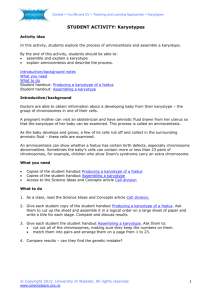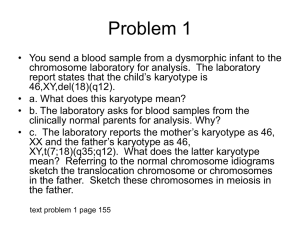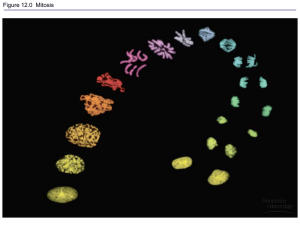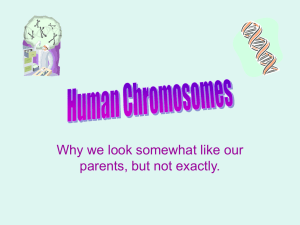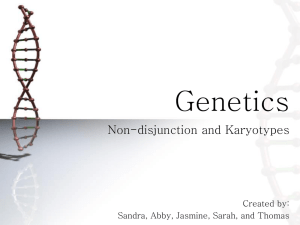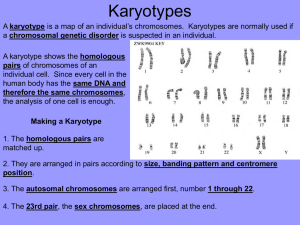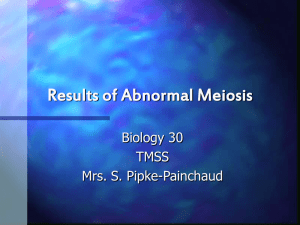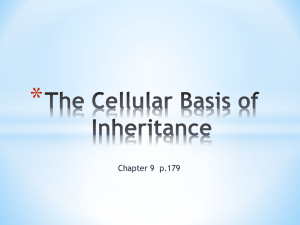Name - TeacherWeb
advertisement
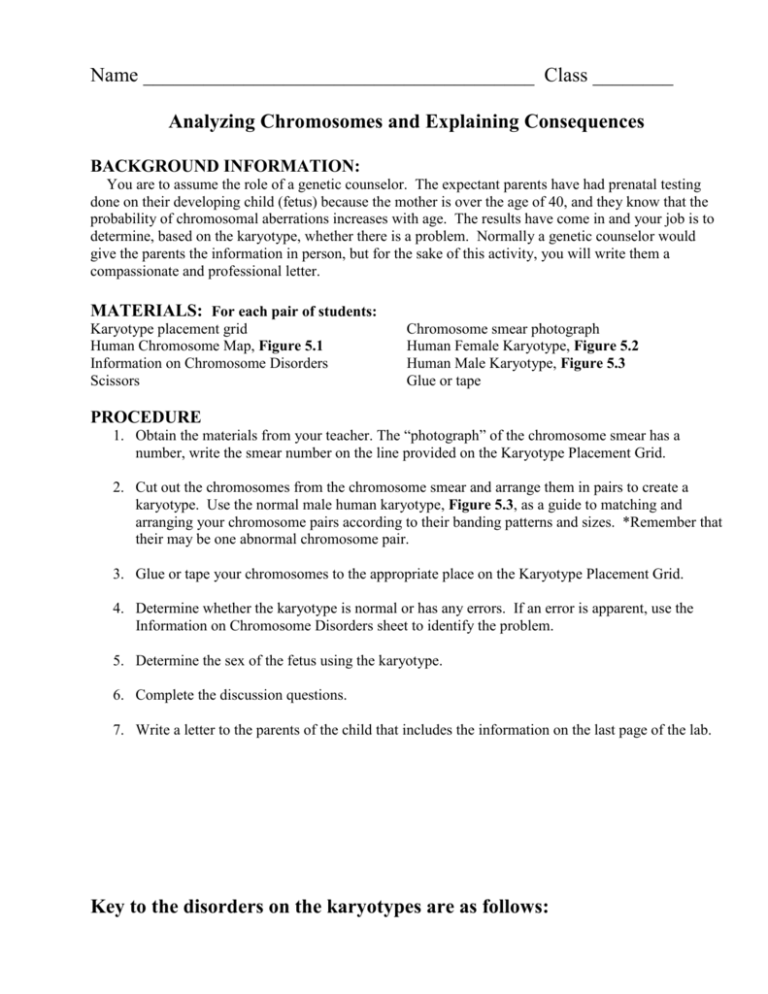
Name _______________________________________ Class ________ Analyzing Chromosomes and Explaining Consequences BACKGROUND INFORMATION: You are to assume the role of a genetic counselor. The expectant parents have had prenatal testing done on their developing child (fetus) because the mother is over the age of 40, and they know that the probability of chromosomal aberrations increases with age. The results have come in and your job is to determine, based on the karyotype, whether there is a problem. Normally a genetic counselor would give the parents the information in person, but for the sake of this activity, you will write them a compassionate and professional letter. MATERIALS: For each pair of students: Karyotype placement grid Human Chromosome Map, Figure 5.1 Information on Chromosome Disorders Scissors Chromosome smear photograph Human Female Karyotype, Figure 5.2 Human Male Karyotype, Figure 5.3 Glue or tape PROCEDURE 1. Obtain the materials from your teacher. The “photograph” of the chromosome smear has a number, write the smear number on the line provided on the Karyotype Placement Grid. 2. Cut out the chromosomes from the chromosome smear and arrange them in pairs to create a karyotype. Use the normal male human karyotype, Figure 5.3, as a guide to matching and arranging your chromosome pairs according to their banding patterns and sizes. *Remember that their may be one abnormal chromosome pair. 3. Glue or tape your chromosomes to the appropriate place on the Karyotype Placement Grid. 4. Determine whether the karyotype is normal or has any errors. If an error is apparent, use the Information on Chromosome Disorders sheet to identify the problem. 5. Determine the sex of the fetus using the karyotype. 6. Complete the discussion questions. 7. Write a letter to the parents of the child that includes the information on the last page of the lab. Key to the disorders on the karyotypes are as follows: Smear Number Name of Disorder Chromosome Abnormality 1 Patau Syndrome trisomy 13 2 Edwards Syndrome trisomy 18 3 Down Syndrome trisomy 21 4 Cri-du-chat deletion in 5 5 Jacobs XYY 6 Turner Syndrome X 7 Klinefelter Syndrome XXY 8 Triple X XXX 9 Philadelphia 9 to 22 translocation Discussion Questions: 1. Describe several features that all the chromosomes in the karyotype have in common ____________________________________________________________________________________ ____________________________________________________________________________________ ____________________________________________________________________________________ 2. Describe the features of the chromosomes that enabled you to identify the matching (homologous) pairs. ____________________________________________________________________________________ ____________________________________________________________________________________ ____________________________________________________________________________________ 3. Did every chromosome have a match? If not, why do you think this is? ____________________________________________________________________________________ ____________________________________________________________________________________ Five Paragraph Essay: You are the geneticist who completed prenatal testing (karyotype) on an unborn child. Your job is to write a letter to the expectant parents detailing the information shown by the karyotype and the possible complications to the fetus (child). Give information about their child’s genetic disorder in a professional but compassionate manner. Be sure to include the following information in your letter Paragraph 1 An introduction to the parents. Introduce yourself and your role (job) Why you are writing this letter? Do not tell the parents the results of the test in the introduction Paragraph 2 Basic overview of human chromosomes describing what they are and how many are found in human cells. Describe what information the DNA on the chromosomes carries. Why an error (mutation) in the DNA or chromosome number or structure can result in variations in traits which can cause problems to the organism. Paragraph 3 What is a Karyotype? How is a karyotype created? What information can a karyotype show us? Give the results of their child’s karyotype? Where is the chromosomal abnormality located? Paragraph 4 Name of the Disorder Description of the disorder o How does it occur? o Birth statistics How this problem might manifest (show up) itself in the child physically, emotionally and developmentally. o Symptoms What are available options for treatment? Paragraph 5 Conclude your letter by inviting the parents to come see you in order to discuss what alternative they have and personal decisions they might make in light of the findings of the results. Mention that their child’s karyotype is included with the letter. Remember that your letter must be clear, explain things simply yet completely, and be sensitive to the parents. Sentences must start with a Capital letter and have end punctuation. Check subject/verb agreement and spelling. Letter Format: [Company Name] [Street Address] [City, ST ZIP Code] [Date] [Recipient Name] [Street Address] [City, ST ZIP Code] Dear [Recipient Name]: Introduction Paragraph 1-An introduction to the parents. Introduce yourself and your role (job). Why you are writing this letter? Do not tell the parents the results of the test in the introduction . Paragraph 2- Overview of DNA, chromosomes and mutations. Be sure to tell the parents how many chromosomes are typically found in human cells. Describe what information the DNA on the chromosomes carries. Why an error (mutation) in the DNA or chromosome number or structure can result in variations in traits which can cause problems to the organism. Explain technical terms. Paragraph 3- Describe the test completed by your (karyotype). How was karyotype created? What information can a karyotype show? Reveal the results of their child’s test. Where is the chromosomal abnormality located? Paragraph 4- Name of the Disorder. Description of the disorder. How does it occur? Birth statistics. How this problem might manifest (show up) itself in the child physically, emotionally and developmentally. Symptoms. What are available options for treatment? Conclusion – Paragraph 5 Conclude your letter by inviting the parents to come see you in order to discuss what alternative they have and personal decisions they might make in light of the findings of the results. Mention that their child’s karyotype is included with the letter. Sincerely, [Your full Name] [Title] Enclosure: Karyotype

